... I never knew her, because she died two years before I was born. So today I want to write down what I have learned about her since my childhood.
My maternal grandmother Johanne Meyer was born on 2 December 1887 in Rathsdamnitz near Stolp in Pomerania, the third child of Maria Heinrich August Meyer from Cologne and Katharina Margarethe Sulzer from Gauangelloch in the Odenwald.
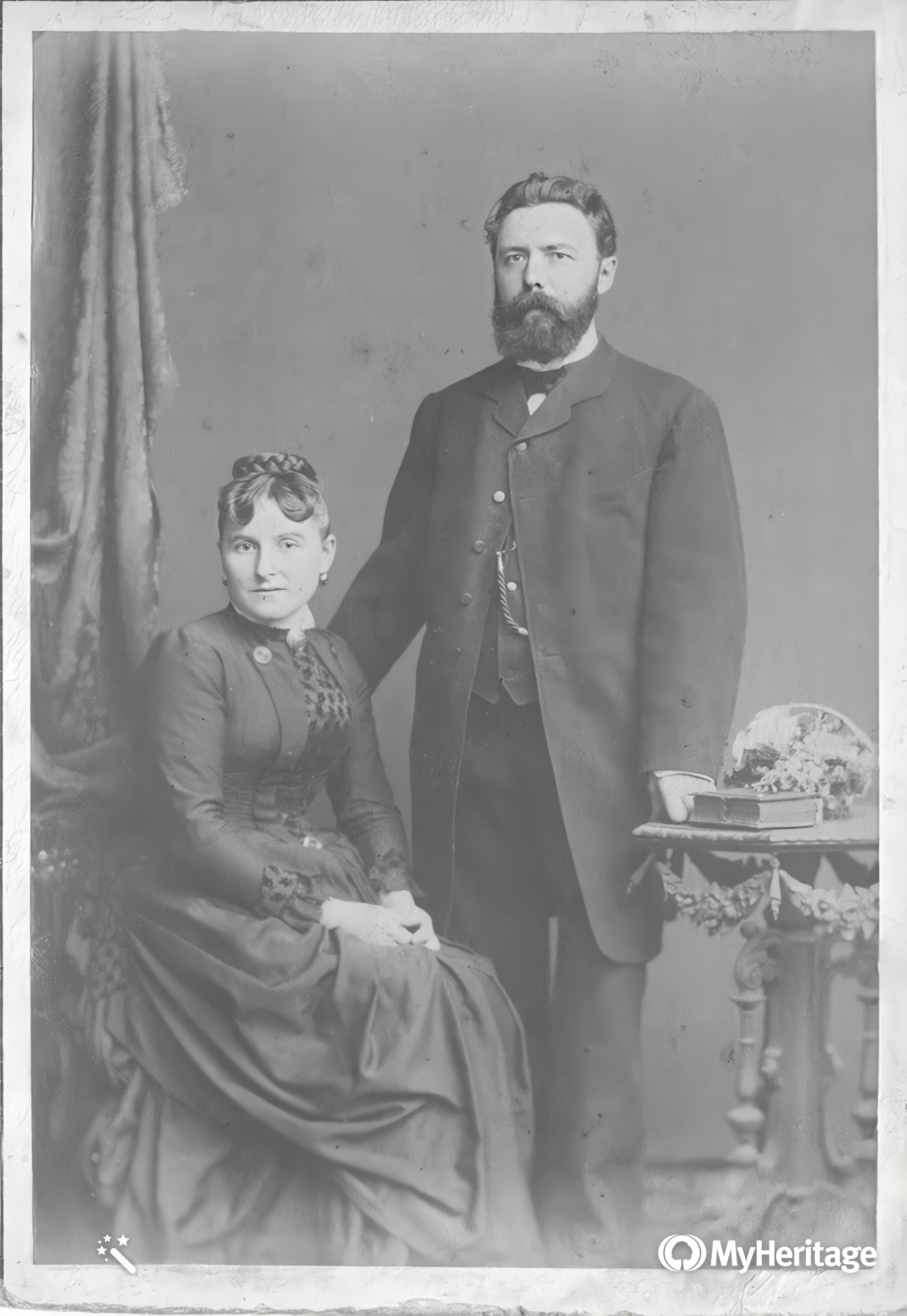
How Sulzer's Gret, a butcher's and innkeeper's daughter from Baden, and the son of a middle-class merchant's family from the Rhineland-Westphalia region met, I do not know, the story of this marriage can be read in "Sulzer's Gret".
In any case, Johanne didn't say much about her father, no wonder, because there was more whispering than talking about "August Maria" in the family. This marriage was divorced, and the Sulzers Gret would have killed anyone who mentioned this husband before her.
Why the family was in Pomerania in 1887 is easy to guess: The Meyer again had a new job. It must have been the umpteenth job since the marriage.
Johanne, actually: Auguste Ottilie Johanne, was named after her godmother, her father's sister Auguste Ottilie MEYER, *1867 in Cologne. Ottilie is said to have been a governess for a noble family in Switzerland. She is said to have met an American there, married him and gone to America with him: I don't know more about her, everything is unconfirmed.
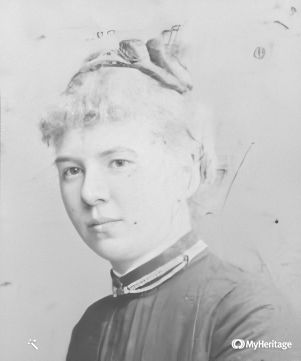
This photo is supposed to represent the godmother Ottilie Meyer.
Johanne received a silver, blue and turquoise enamelled pendant from her (again allegedly!) for her confirmation (around 1901/02). There is this photo of Johanne wearing it: I still have it today and wear it sometimes.
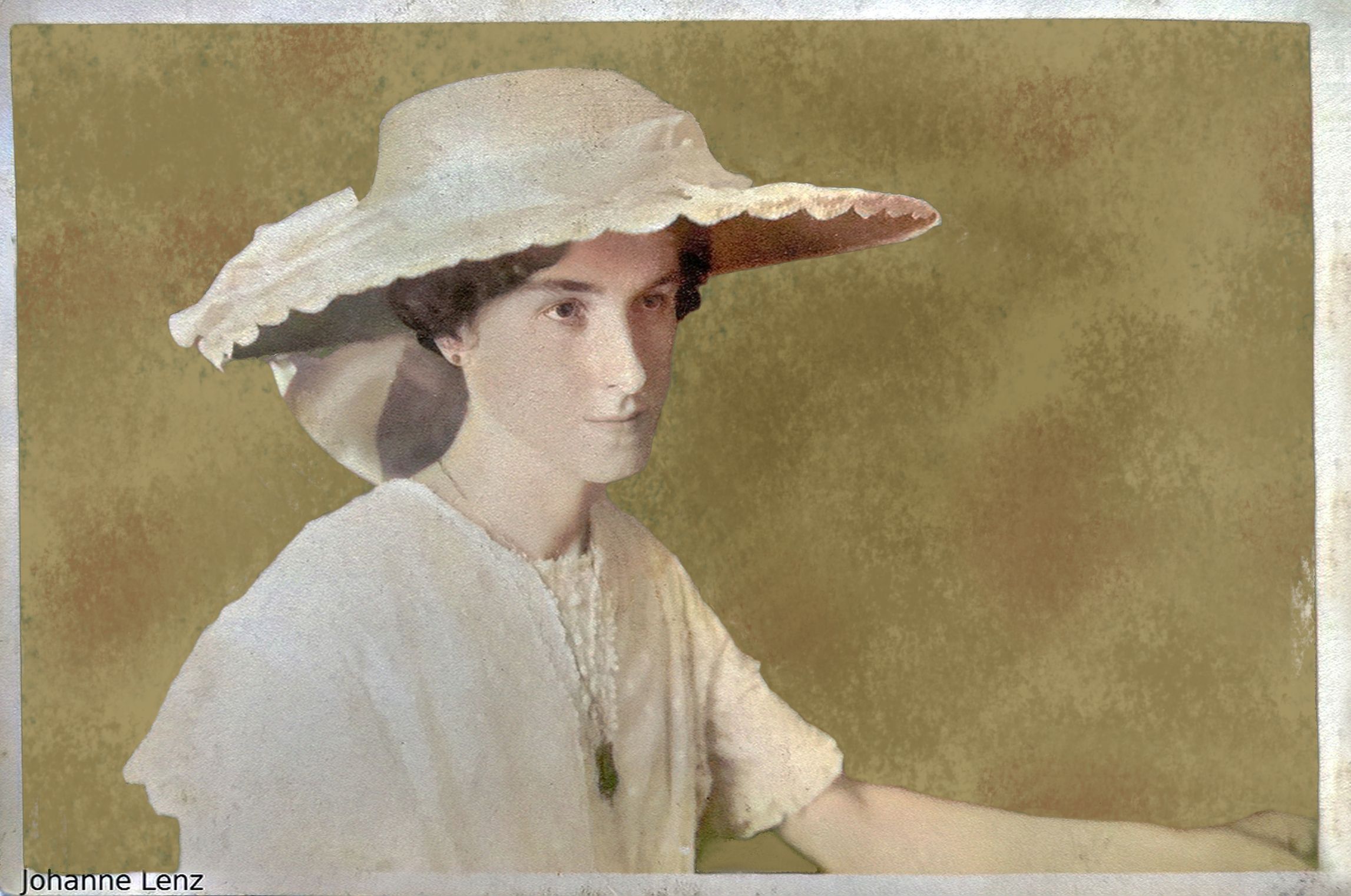
Johanne with the pendant, she is of course older than 14 or 15 on the photo.
My mother Elfriede always told me that there was supposed to have been a tutor in the family. But it's uncertain where the episode of the tutor is supposed to have taken place. Paper factories were often located somewhat away from villages and small towns, so it is possible that school attendance was not possible and Lisl therefore had to be taught at home. But she was not old enough to learn until about 1888. At the time the family lived at the paper factory of Rathsdamnitz which was really quite a bit outside the village. Johanne wouldfirst have gone to school 1893/94 - by then the family was already back in the Odenwald, at least the mother with the three children (see the story of "Sulzer's Gret"). So no tutor for Johanne.
In 1891, little brother Maria Otto August was born in Copitz near Pirna in Saxony.
Soon after, the parents' marriage was totally broken up. August Maria had (allegedly!) once again squandered all his money with one of his eternal inventions, and wanted - according to my mother for the third time - to go to America. Sulzer's Gret wasn’t having it. He had already been over there twice without success, and the family had moved all over Germany: Now she had had enough.
Mother and children probably moved to Spechbach as early as 1893, where Gret's sister Katharina was married to Sebastian Schleidt. She was ill and died in March 1894. The brother-in-law married for the second time in June 1895, Gret then lived in Mannheim as "wife of the technician August Meyer" and had her own administrative family sheet there.
The Schleidts' estate in Spechbach was a little outside the village, which was probably the time when Johanne went to school "through the forest".
At that time she had a tame squirrel and a tame magpie that accompanied her, sitting on her two shoulders, to the edge of the forest and awaited her there again after class. She must have been a real tomboy, climbing trees and tearing her aprons and skirts (unavoidable with the clothes of the time!).
But Johanne was not only an intelligent child, she also had what is usually called "the second sight" at times. One day in Spechbach, Johanne firmly claimed that there was a treasure under the floorboards of a certain room: she had dreamt it, she said.
When the floorboards in this room were renewed a few years later, a number of gold coins were found there. As a young girl, she also "dreamt" of the outbreak of World War I and accurately predicted the year it would begin. This side of her personality has been passed on at least so much to my mother and to me that my father sometimes said he lived with two witches. Well... This talent is much more pronounced in Johannes' second grandchild, my cousin Hannelotte. She really does amazing things in this respect, because her own mother was also "one of those", even if she didn't want to admit it.
The Meyer marriage was not divorced until 1902, after August Meyer had worked in Mannheim and other places, had not paid a penny for his family for years and had not lived with them. According to the divorce decree, he had pretended to be a widower (!) in Ettlingen, where he had also worked (presumably in the Buhl paper factory). In the autumn of 1898 he left Mannheim for Switzerland, as Lisl stated in the divorce proceedings, ... and was never seen again...
Gret remarried in Mannheim in 1903, to a very dear man called Andreas Schäfer, who became the only great-grandfather I ever knew. The years leading up to her remarriage must have been hard for her and the children. How hard is uncertain; in any case, Johanne was apprenticed as an office worker at the age of 13, Lisl went to Heidelberg as a domestic servant in the summer of 1898. Her deregistration from the Mannheim police is still available.
The father having disappeared without a trace since autumn 1898, the 20-year-old son Otto had to find out his father's nationality before he could report for military service. Before his return to Germany in 1883, August had allegedly acquired a certificate of nationality in Philadelphia and had not wanted to be renaturalised German. He had renounced his Prussian nationality in 1878 and wanted to emigrate to Switzerland (even then!). Otto was therefore classified as stateless and had to serve in Saxony because he had been born there. In February 1914, during his military service, he complained of dizziness and fever, the NCO in charge called him a shirker and chased him criss-cross across the barracks yard until he collapsed. He died two days later of pneumonia.
Johanne did an apprenticeship as an office worker in Mannheim. At that time, this already included mastering the typewriter and shorthand. I still have certificates from various companies where she worked: From 2 July 1901 (She was 13!) to 22 August 1905 she did "light clerical work" at the "Kalk-, Gips- und Chamotte-Zeitung, Verlag Oskar Mokrauer-Mainé" and towards the end of this apprenticeship she was at the same time temporarily employed as a "contoirist" for a few weeks at "Felix Falk, Baumwollabfälle". Sometime after that, she joined the AEG in Mannheim as a trained office worker, where she met her future husband, the electrician Franz Joseph Lenz, a few years before the start of the First World War. Johanne was engaged to someone else at the time, but things broke up (because of my later grandfather or because of the war?): the fiancé's farewell card to "his dear Johanna" still exists.
Franz Joseph, called Sepp, was called up for military service in 1912. During his second year of service, World War I broke out. Sepp spent the entire war in constant movement between the Western and Eastern fronts, in his own words: "...up and down, by train and on foot until the end of the war".
The two wanted to marry in May 1916 on the occasion of Sepp’s first home leave. When looking for the necessary papers, Johanne, unlike her brother, was certified as an American citizen. At this point, the Americans in Germany were no longer considered as neutral: my future grandmother only narrowly escaped internment as an "enemy alien".

23.5.1916: In the morning they went to the registry office...

... and in the afternoon to the Protestant church wedding. I still have the wedding bible.
Johanne must have been an office manager at AEG at that time, because there are photos of the office where she is described as such. Her working clothes in the office at that time: a long dark dress, with a white frilled bib apron!
Outside the office Johanne was very elegant, even as a young woman. She was quite tall for her time (1.68m), slim, dark-eyed, with a very fair complexion and chestnut brown hair. The fashion of the time suited her perfectly. She had a good face for hats and very good taste in the composition and cut of her clothes. Everyone who knew her mentioned her ladylike bearing.

Johanne (centre) with two colleagues
The Meyer siblings were all three beautiful people: Luise had a rather full face as a young girl, with her father's features, dark eyes and rich dark red hair. I still saw it as a child: It had survived very well between her death in 1907 and the dissolution of the grave a few decades later. Her stepfather Schäfer kept the tresses in his desk at the time, where they lay until his death in 1952. Otto was also tall and well-built, his nephew Heinrich, my uncle, looked very much like him. (Photos in the history of Sulzer's Gret).
After her marriage, Johanne, as was customary, immediately stopped working; married female employees were generally undesirable and also required the husband's permission. Son Heinrich was born in January 1917 as a seven-month premarure baby, in Mannheim, O7,4 where the young couple lived with Johanne's mother and stepfather. Little Heinrich was a particularly weak child, who cried constantly in a thin voice and wobbled his head for three months. His step-great-aunt, Mrs Schleidt, came from Spechbach for inspection and commented after her return: "I don’t know if he is still alive!” The feeble baby grew up well, though, because my uncle Heini was quite a big lump later on.
This photo from the day of his christening was sent to his father in the field, but he wasn't allowed to see his son until much later.

After the war, Sepp immediately returned to work at AEG, but continued his education in evening classes and passed his master's examination as an electrician and radio technician in June 1919.
In 1922, still in O7,4, daughter Elfriede was born. Again a home birth, as was customary at the time, but this time the father was present - fortunately! The umbilical cord was wrapped around the baby's neck and the midwife lost her head: the young father single-handedly prevented the strangulation and brought the midwife to her senses by swearing at her. Elfriede became my mother.
In 1926 daughter Luzie appeared on the scene, also still in O7,4.
In 1927 Sepp founded a business with a colleague, but ... Here I will let him speak for himself: "On 8.2.1928 we moved to (Neu-Ostheim) Dürerstraβe 16, shop and workshop, after the cooperation with Johann Schmitt broke down after 13 months. After 5 years, we gave up the shop and moved to Dürerstr.12" (from "Wimar's notebook", a booklet that the Lenz-ancestor Wimar found and then used to write down the births of his children and his small business dealings. That will be a story of its own again! It later served as a kind of family chronicle).
Sepp's scant words conceal all sorts of things. After the depression of 1929, the business situation became worse and worse, and in 1933 the first forward-looking Jews began to go abroad. So did the owners of a company for which my grandfather had done extensive electrician’s work. They left without paying their bill first. Understandable from their point of view, but it almost cost my grandfather his business. He had a heart attack and had to give up his flat, workshop and shop at Durerstr. 16. The business continued on a smaller scale at Dürerstraβe 12. Instead of several journeymen and apprentices (up to 8 employees), and the shop, he only had a maximum of three employees, i.e. two apprentices and one journeyman.
Johanne did the bookkeeping right from the start. No problem for her, because that was what she had learned. But since the children, the household and the employees also wanted to be looked after (they were fed, got their work clothes provided and washed), maids were needed. Johanne had two before 1933, then only one. She had already had her beautiful long hair cut off in the 1920s, because putting it up took time she didn't have, and she also hoped that the lighter hairstyle would improve her migraines. Her husband did not speak to her for three weeks out of anger about the lost hair.
My grandfather writes: "After many ups and downs in the business: time of political persecution. Consequence: incorporated in the SA = S.H.D. (Security Service, Air Protection Department), business had to be closed."
That was shortly after the outbreak of World War II. Between 1933 and that time, the business never fully recovered, not least because Sepp refused to join the NSDAP. Therefore, he no longer received any large installation orders. After losing the business, they opened a small shop for electrical goods in the front room of the new flat, and Sepp repaired irons, bedside lamps and radios in the evenings after work.
Johanne now looked after her people alone, without a maid. But that did not dampen her thirst for knowledge. She always had her nose in a book, learned languages and sometimes forgot to cook. Apart from that, she was very meticulous with a few idiosyncrasies. At Lenzens', as was often the case in Germany, they always had cold supper, i.e. Johanne made sandwiches for the whole family at the table. She always had several knives in front of her, one for butter, one for spreadable sausage, one for sliced sausage, one for hard cheese, one for soft cheese...Where did she learn that? No idea! Only the cleaning of the kippers was done by my grandfather: he also did it at the dining table, on newspaper, even after the war, when I was already born. I was always fascinated by how well he could do it!
(Addendum: At the beginning of their marriage, Sepp had bought his Johanne a two-volume manual about keeping house and cooking, because she had not been able to learn how to manage properly with her mother because of her work. According to my mother, these books were none of Johanne's favourites, but they were mine ! They are a rich source of information about domestic life at the turn of the century, and there are many excellent recipes. But the drollest thing are the pictures and explanations about, for example, "the ironing and folding of open ladies' underpants"!).
During the Third Reich, Johanne was always well informed, despite censorship and the Volksempfänger radio with its standardised programme. She secretly listened to the forbidden stations, because my grandfather, as a radio technician, had been able to build a device that also received other wavelengths. She was often so outraged that she would stand at the living room window, scolding loudly, and tell passers-by about the latest outrages of the rulers.
In the workshop in the basement, or in the cellar itself, she occasionally hid endangered people, just for a night or so, but that would still have landed her in aconcentration camp if the affair had been discovered - and the family with it. Fortunately, the block warden was one of Sepp's friends and didn't say anything, even sent advance warning if he got wind of a raid.
Johanne kept a tight rein on her children. This was necessary with Heini, because he was rumbunctious and a bit of a bully. Her hand slipped easily, right and left around the sinner's ears, which is why her son and his mates called her the "Schlackertaste" (= approximately a typwriter key that doesn’t stop bouncing). But the success was still there more than half a century later, because when my uncle saw me again after quite some time, in the 80s, he turned pale and stammered in amazement: "Oh God, she could be Johanne!", ... and treated me with noticeable respect afterwards.
My mother Elfriede was a very good little girl, but even she also told me that she caught her last slap from her mother's hand when she was already 22.
The youngest sister Luzie was a little pest. A very bright child, full of the spirit of contradiction and always looking for something new to do. Once she tried the Eau de Cologne from the bottle on the washstand: the marble slab still shows the stains that the alcohol made when she quickly spat the stuff out. Another time Luzie disappeared again without a trace (she ran away whenever she could), the family in full commotion, until a customer located the three-year-old in the shop window, where she was making faces at passers-by. At the age of five, she met with a fatal accident. This is how it happened: Behind the residential buildings in Dürerstrasse are large terraces with garages built underneath. There is a good one storey down into the so-called car yard. The terraces of the individual buildings are separated by a walls over a man's height, which cannot be climbed over easily. To get from one terrace to the other, the older children climbed around the front of the wall, holding on to the terrace railings. The little one tried to do the same, fell down and died the day after next.
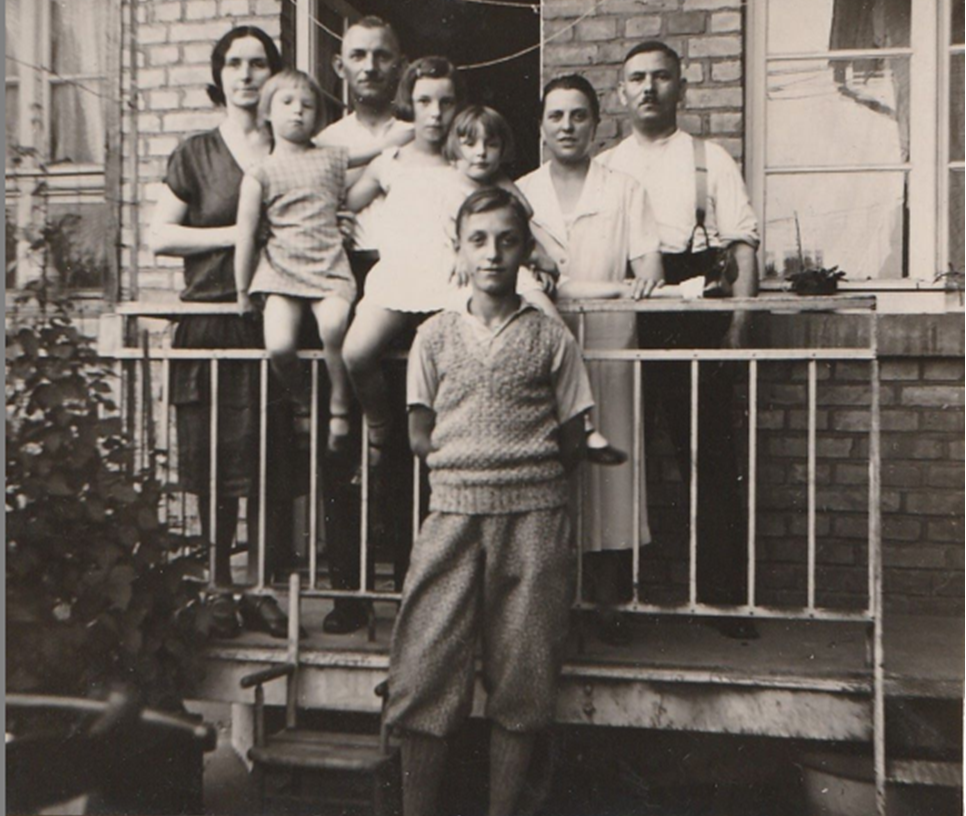
Dürerstr. 16, Heini in front, Johanne, Luzie (her only photo), Sepp, Friedel, cousin Erika, daughter of Lina and Matjö Lenz behind her.
Johanne loved animals very much, she almost always had a cat in the house and also took in pets whose owners needed temporary accommodation for them. Apart from the various pussies, there was Lora, the grey parrot, and Cora, the Newfoundland dog, who stayed for months. Heinz Gutjahr, a buddy of her son's who lived in the same house, used to say that he wanted to become a cat with Mrs Lenz in a new life. One of these dear little animals had her kittens one night in the coffee cosy on the kitchen cupboard.
The family could not afford a car, but they had bicycles. So on many a Sunday they went for a ride in the countryside. The totally unathletic but elegant Johanne in her hat and pumps sat very stiffly and somewhat wobbly on her bicycle. Well, that's how she fell and broke a heel. The bike was warped and could only be pushed. Johanne walked, according to her habit, amlost on the tip of her toes until she got home, where she discovered the mishap with the broken heel. No one from the family had said anything about it, they only pushed, bending with suppressed laughter, behind the floating Johanne. Another time, however, her elegance got her in a bad way: She was wearing a straw hat with large red poppies made of fabric and a white dress. Unfortunately there was a thunderstorm, the beautiful poppies were not colourfast, and the nice white dress was streaked with red...
During the Second World War, Johanne contracted tuberculosis in an air-raid shelter. She had already been in a sanatorium before she got married, as a card from her future father-in-law to her shows. My mother caught her mother’s tuberculosis, which gave her a so-called cavern, a scarring in the lungs, but it healed on its own. She only found out about it during the compulsory examination before her marriage in 1947.
When Johanne’s husband and her children returned from the war, she was already very ill, but by no means did she want to remain mentally unoccupied. She read everything she could get her hands on. The American occupation interested instead of irritated her, she brought out her best English to converse with Charlie, the family's black good angel (see Putzibam story). Unfortunately, she was not allowed to enjoy these more peaceful times for long. Admission to a sanatorium was rejected by the administrative authorities: They needed the places for younger people. Elfriede cared for her mother until her death in August 1946.
Johanne’s last Christmas was in 1945, and there is her very last photo of her sitting at the coffee table with her daughter Elfriede (Friedel), the American soldier Charlie from the Putzibam story and her mother-in-law Luzie Lenz, née Knäpper.
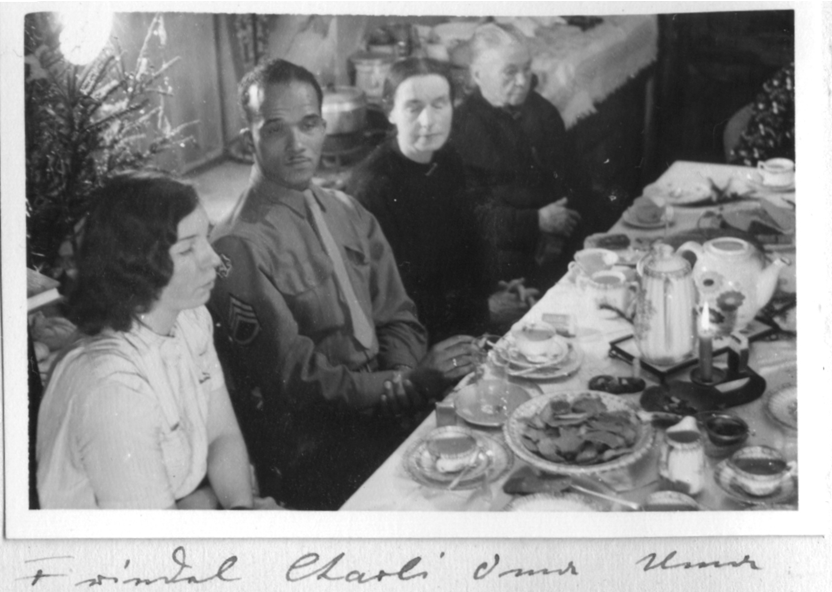
I still have the big book that Johanne loved to read in her last days: The "Bildersaal der Deutschen Geschichte", a collection of engravings and texts from 1899. On the last page, the new year 1900 rises radiantly like the sun over the horizon. As a child, I always enjoyed reading it and looking at the many beautiful pictures - just like Johanne once did. Today, there are still coffee stains on some of the pages and also a few crumbs that she left behind...
= = = = =



